Legal Business Environment: Examining Australian Power Divisions
VerifiedAdded on 2023/06/12
|7
|1653
|463
Report
AI Summary
This report provides an in-depth analysis of the separation and division of powers within the Australian legal business environment. It elucidates the concept of separation of powers, highlighting the distinct roles of the legislature, executive, and judiciary in ensuring governmental oversight and preventing arbitrary use of power. The report also explores the division of powers between the federal and state governments in Australia, emphasizing the constitutional basis for legislative authority at both levels. It further examines the practical challenges to the strict separation of powers, particularly concerning delegated legislation and the relationship between the executive and legislative branches. The report concludes by underscoring the importance of transparency and accountability in governance, facilitated by the separation of powers, to safeguard citizens' rights and maintain public trust. Desklib offers a platform to explore similar solved assignments and past papers for students.
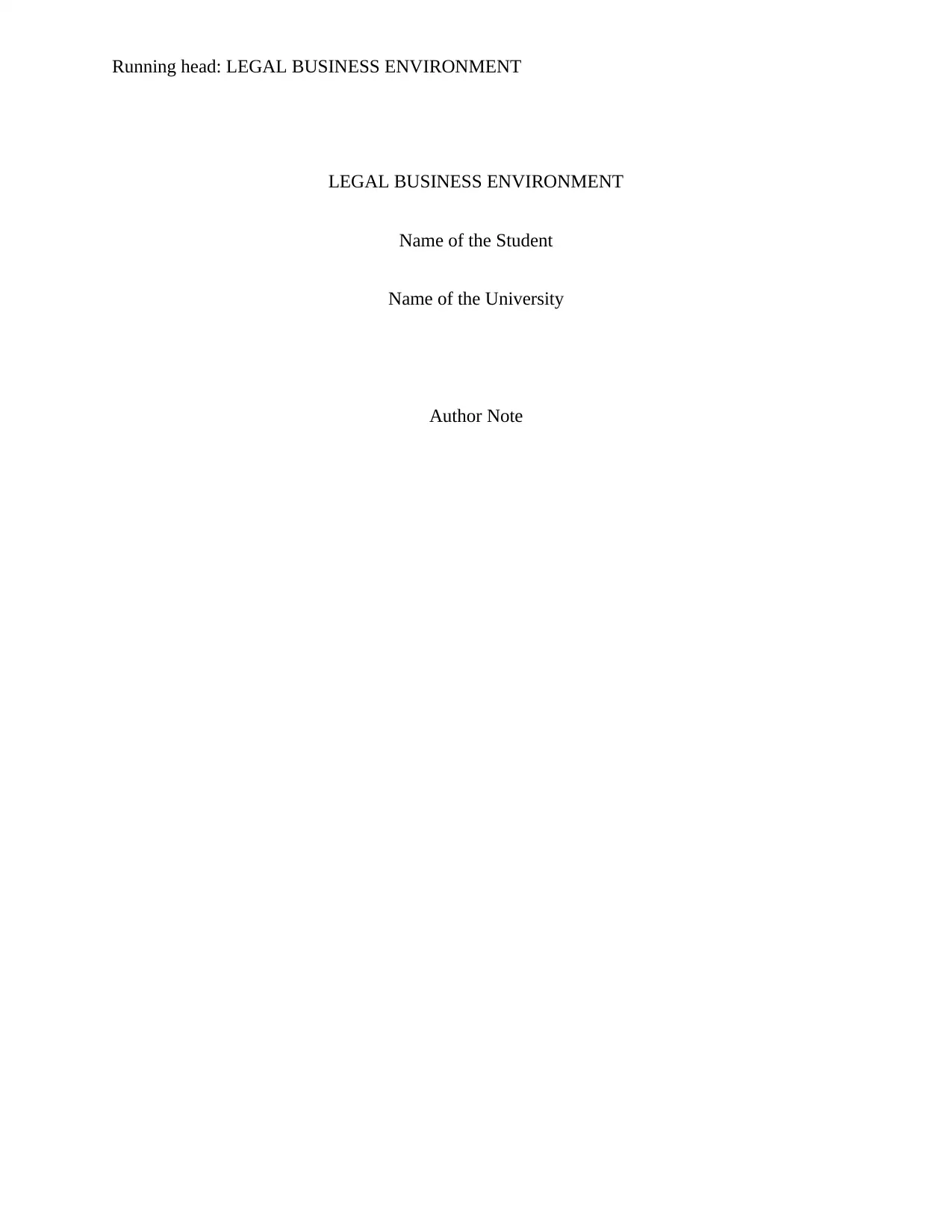
Running head: LEGAL BUSINESS ENVIRONMENT
LEGAL BUSINESS ENVIRONMENT
Name of the Student
Name of the University
Author Note
LEGAL BUSINESS ENVIRONMENT
Name of the Student
Name of the University
Author Note
Paraphrase This Document
Need a fresh take? Get an instant paraphrase of this document with our AI Paraphraser
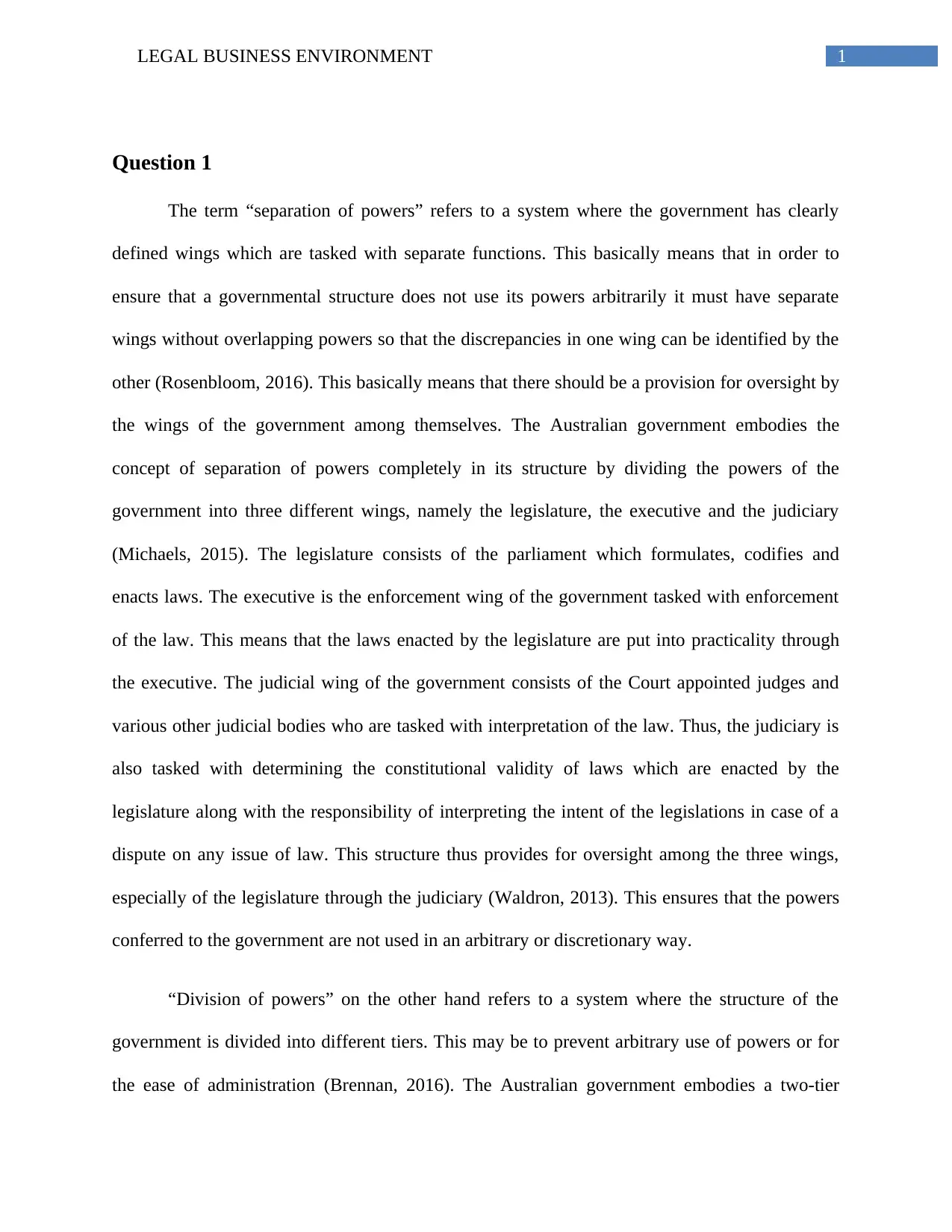
1LEGAL BUSINESS ENVIRONMENT
Question 1
The term “separation of powers” refers to a system where the government has clearly
defined wings which are tasked with separate functions. This basically means that in order to
ensure that a governmental structure does not use its powers arbitrarily it must have separate
wings without overlapping powers so that the discrepancies in one wing can be identified by the
other (Rosenbloom, 2016). This basically means that there should be a provision for oversight by
the wings of the government among themselves. The Australian government embodies the
concept of separation of powers completely in its structure by dividing the powers of the
government into three different wings, namely the legislature, the executive and the judiciary
(Michaels, 2015). The legislature consists of the parliament which formulates, codifies and
enacts laws. The executive is the enforcement wing of the government tasked with enforcement
of the law. This means that the laws enacted by the legislature are put into practicality through
the executive. The judicial wing of the government consists of the Court appointed judges and
various other judicial bodies who are tasked with interpretation of the law. Thus, the judiciary is
also tasked with determining the constitutional validity of laws which are enacted by the
legislature along with the responsibility of interpreting the intent of the legislations in case of a
dispute on any issue of law. This structure thus provides for oversight among the three wings,
especially of the legislature through the judiciary (Waldron, 2013). This ensures that the powers
conferred to the government are not used in an arbitrary or discretionary way.
“Division of powers” on the other hand refers to a system where the structure of the
government is divided into different tiers. This may be to prevent arbitrary use of powers or for
the ease of administration (Brennan, 2016). The Australian government embodies a two-tier
Question 1
The term “separation of powers” refers to a system where the government has clearly
defined wings which are tasked with separate functions. This basically means that in order to
ensure that a governmental structure does not use its powers arbitrarily it must have separate
wings without overlapping powers so that the discrepancies in one wing can be identified by the
other (Rosenbloom, 2016). This basically means that there should be a provision for oversight by
the wings of the government among themselves. The Australian government embodies the
concept of separation of powers completely in its structure by dividing the powers of the
government into three different wings, namely the legislature, the executive and the judiciary
(Michaels, 2015). The legislature consists of the parliament which formulates, codifies and
enacts laws. The executive is the enforcement wing of the government tasked with enforcement
of the law. This means that the laws enacted by the legislature are put into practicality through
the executive. The judicial wing of the government consists of the Court appointed judges and
various other judicial bodies who are tasked with interpretation of the law. Thus, the judiciary is
also tasked with determining the constitutional validity of laws which are enacted by the
legislature along with the responsibility of interpreting the intent of the legislations in case of a
dispute on any issue of law. This structure thus provides for oversight among the three wings,
especially of the legislature through the judiciary (Waldron, 2013). This ensures that the powers
conferred to the government are not used in an arbitrary or discretionary way.
“Division of powers” on the other hand refers to a system where the structure of the
government is divided into different tiers. This may be to prevent arbitrary use of powers or for
the ease of administration (Brennan, 2016). The Australian government embodies a two-tier
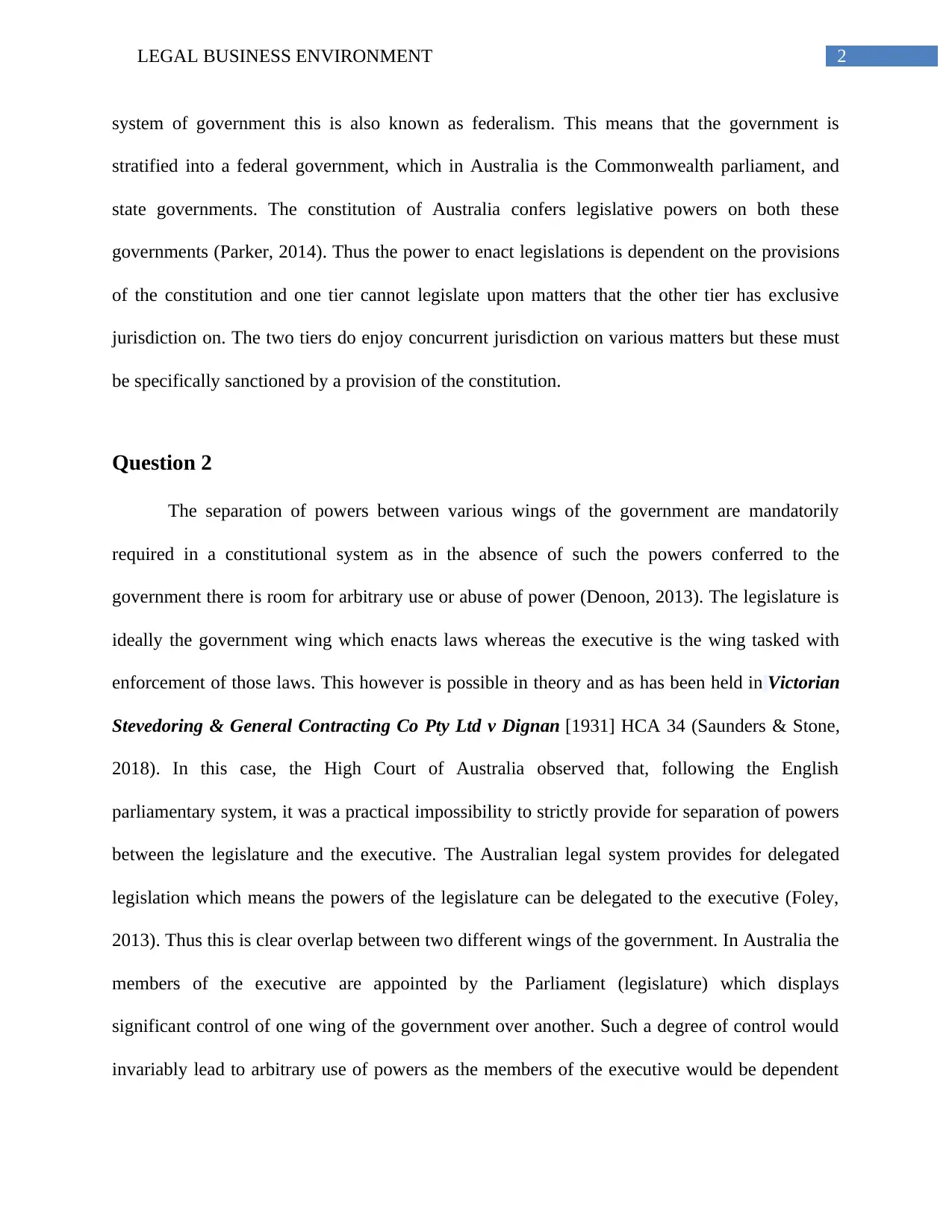
2LEGAL BUSINESS ENVIRONMENT
system of government this is also known as federalism. This means that the government is
stratified into a federal government, which in Australia is the Commonwealth parliament, and
state governments. The constitution of Australia confers legislative powers on both these
governments (Parker, 2014). Thus the power to enact legislations is dependent on the provisions
of the constitution and one tier cannot legislate upon matters that the other tier has exclusive
jurisdiction on. The two tiers do enjoy concurrent jurisdiction on various matters but these must
be specifically sanctioned by a provision of the constitution.
Question 2
The separation of powers between various wings of the government are mandatorily
required in a constitutional system as in the absence of such the powers conferred to the
government there is room for arbitrary use or abuse of power (Denoon, 2013). The legislature is
ideally the government wing which enacts laws whereas the executive is the wing tasked with
enforcement of those laws. This however is possible in theory and as has been held in Victorian
Stevedoring & General Contracting Co Pty Ltd v Dignan [1931] HCA 34 (Saunders & Stone,
2018). In this case, the High Court of Australia observed that, following the English
parliamentary system, it was a practical impossibility to strictly provide for separation of powers
between the legislature and the executive. The Australian legal system provides for delegated
legislation which means the powers of the legislature can be delegated to the executive (Foley,
2013). Thus this is clear overlap between two different wings of the government. In Australia the
members of the executive are appointed by the Parliament (legislature) which displays
significant control of one wing of the government over another. Such a degree of control would
invariably lead to arbitrary use of powers as the members of the executive would be dependent
system of government this is also known as federalism. This means that the government is
stratified into a federal government, which in Australia is the Commonwealth parliament, and
state governments. The constitution of Australia confers legislative powers on both these
governments (Parker, 2014). Thus the power to enact legislations is dependent on the provisions
of the constitution and one tier cannot legislate upon matters that the other tier has exclusive
jurisdiction on. The two tiers do enjoy concurrent jurisdiction on various matters but these must
be specifically sanctioned by a provision of the constitution.
Question 2
The separation of powers between various wings of the government are mandatorily
required in a constitutional system as in the absence of such the powers conferred to the
government there is room for arbitrary use or abuse of power (Denoon, 2013). The legislature is
ideally the government wing which enacts laws whereas the executive is the wing tasked with
enforcement of those laws. This however is possible in theory and as has been held in Victorian
Stevedoring & General Contracting Co Pty Ltd v Dignan [1931] HCA 34 (Saunders & Stone,
2018). In this case, the High Court of Australia observed that, following the English
parliamentary system, it was a practical impossibility to strictly provide for separation of powers
between the legislature and the executive. The Australian legal system provides for delegated
legislation which means the powers of the legislature can be delegated to the executive (Foley,
2013). Thus this is clear overlap between two different wings of the government. In Australia the
members of the executive are appointed by the Parliament (legislature) which displays
significant control of one wing of the government over another. Such a degree of control would
invariably lead to arbitrary use of powers as the members of the executive would be dependent
⊘ This is a preview!⊘
Do you want full access?
Subscribe today to unlock all pages.

Trusted by 1+ million students worldwide
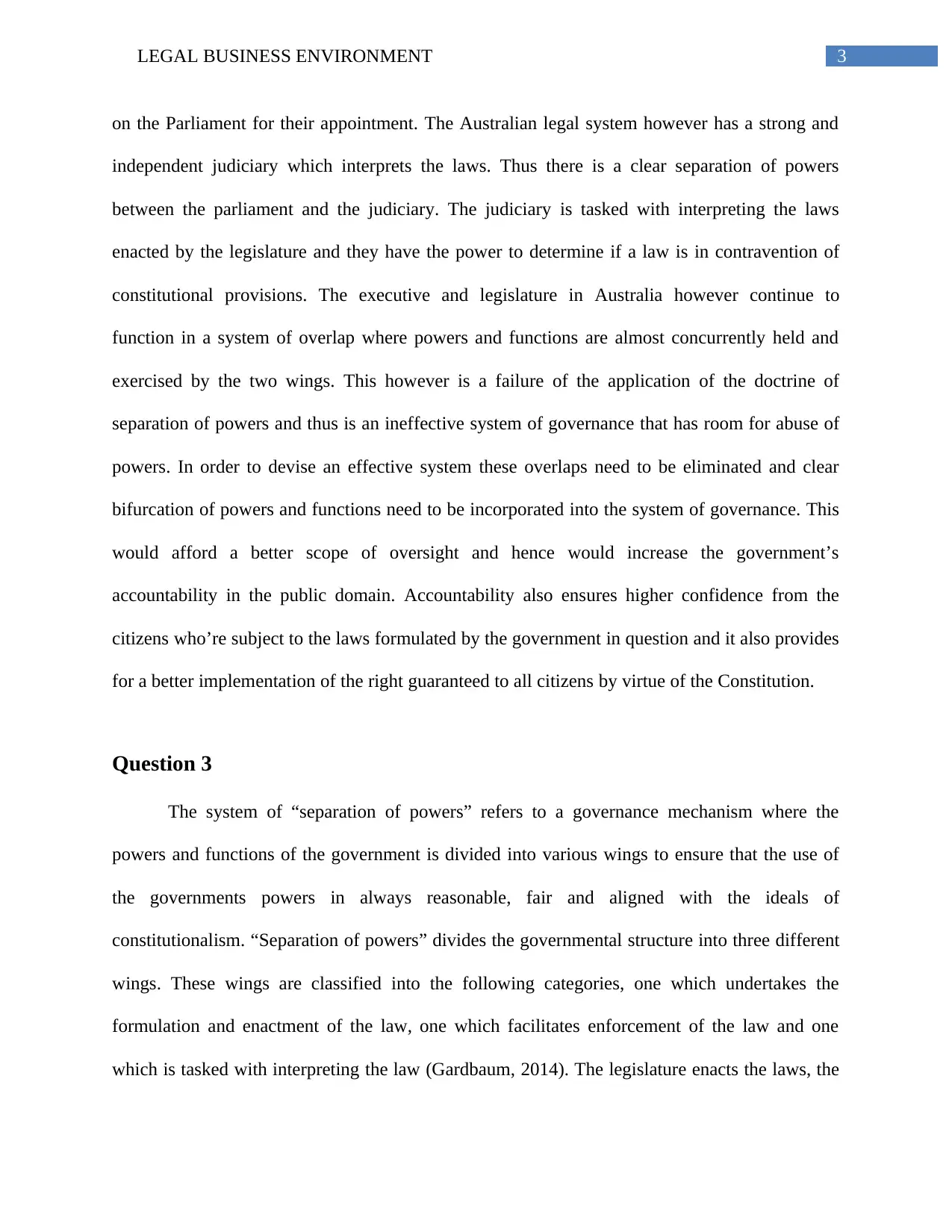
3LEGAL BUSINESS ENVIRONMENT
on the Parliament for their appointment. The Australian legal system however has a strong and
independent judiciary which interprets the laws. Thus there is a clear separation of powers
between the parliament and the judiciary. The judiciary is tasked with interpreting the laws
enacted by the legislature and they have the power to determine if a law is in contravention of
constitutional provisions. The executive and legislature in Australia however continue to
function in a system of overlap where powers and functions are almost concurrently held and
exercised by the two wings. This however is a failure of the application of the doctrine of
separation of powers and thus is an ineffective system of governance that has room for abuse of
powers. In order to devise an effective system these overlaps need to be eliminated and clear
bifurcation of powers and functions need to be incorporated into the system of governance. This
would afford a better scope of oversight and hence would increase the government’s
accountability in the public domain. Accountability also ensures higher confidence from the
citizens who’re subject to the laws formulated by the government in question and it also provides
for a better implementation of the right guaranteed to all citizens by virtue of the Constitution.
Question 3
The system of “separation of powers” refers to a governance mechanism where the
powers and functions of the government is divided into various wings to ensure that the use of
the governments powers in always reasonable, fair and aligned with the ideals of
constitutionalism. “Separation of powers” divides the governmental structure into three different
wings. These wings are classified into the following categories, one which undertakes the
formulation and enactment of the law, one which facilitates enforcement of the law and one
which is tasked with interpreting the law (Gardbaum, 2014). The legislature enacts the laws, the
on the Parliament for their appointment. The Australian legal system however has a strong and
independent judiciary which interprets the laws. Thus there is a clear separation of powers
between the parliament and the judiciary. The judiciary is tasked with interpreting the laws
enacted by the legislature and they have the power to determine if a law is in contravention of
constitutional provisions. The executive and legislature in Australia however continue to
function in a system of overlap where powers and functions are almost concurrently held and
exercised by the two wings. This however is a failure of the application of the doctrine of
separation of powers and thus is an ineffective system of governance that has room for abuse of
powers. In order to devise an effective system these overlaps need to be eliminated and clear
bifurcation of powers and functions need to be incorporated into the system of governance. This
would afford a better scope of oversight and hence would increase the government’s
accountability in the public domain. Accountability also ensures higher confidence from the
citizens who’re subject to the laws formulated by the government in question and it also provides
for a better implementation of the right guaranteed to all citizens by virtue of the Constitution.
Question 3
The system of “separation of powers” refers to a governance mechanism where the
powers and functions of the government is divided into various wings to ensure that the use of
the governments powers in always reasonable, fair and aligned with the ideals of
constitutionalism. “Separation of powers” divides the governmental structure into three different
wings. These wings are classified into the following categories, one which undertakes the
formulation and enactment of the law, one which facilitates enforcement of the law and one
which is tasked with interpreting the law (Gardbaum, 2014). The legislature enacts the laws, the
Paraphrase This Document
Need a fresh take? Get an instant paraphrase of this document with our AI Paraphraser
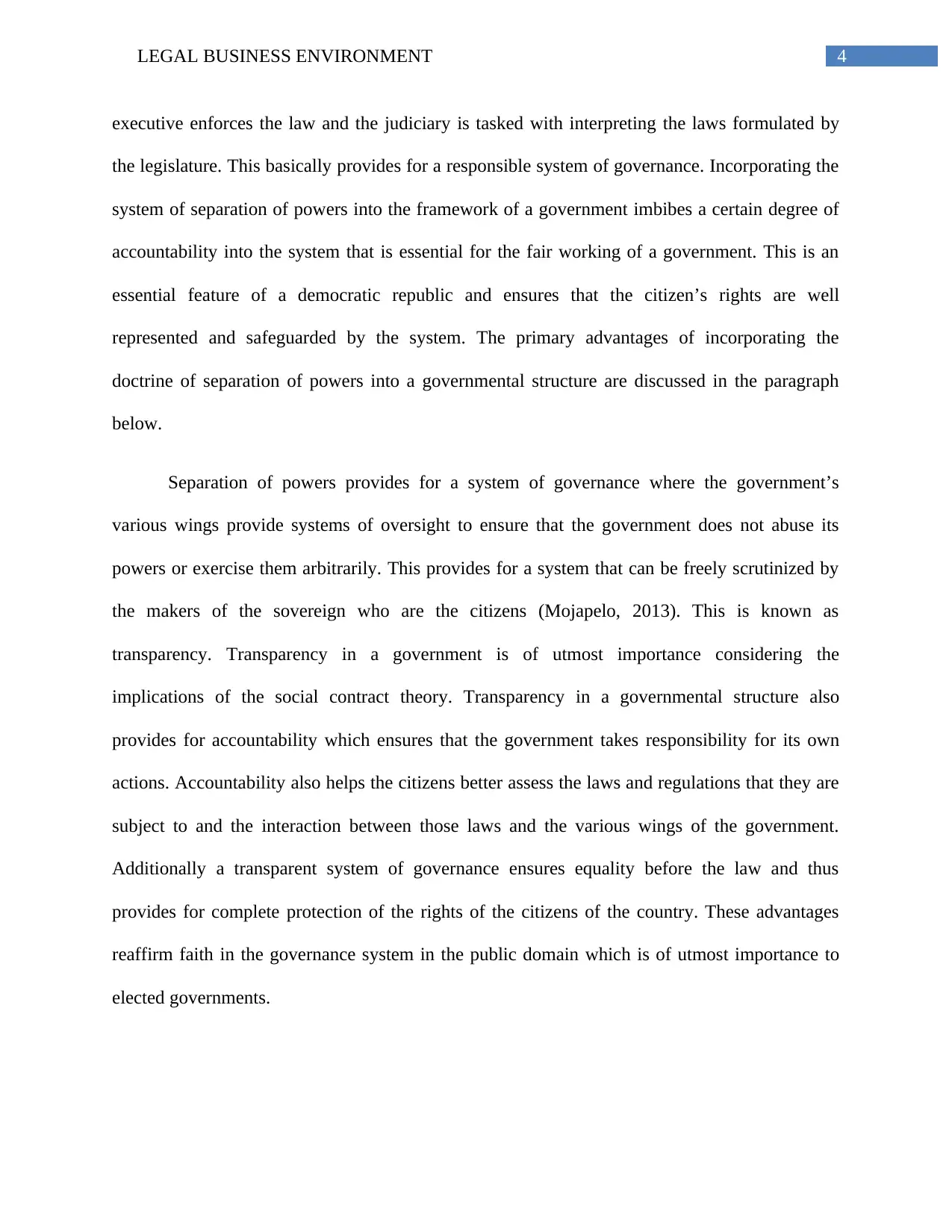
4LEGAL BUSINESS ENVIRONMENT
executive enforces the law and the judiciary is tasked with interpreting the laws formulated by
the legislature. This basically provides for a responsible system of governance. Incorporating the
system of separation of powers into the framework of a government imbibes a certain degree of
accountability into the system that is essential for the fair working of a government. This is an
essential feature of a democratic republic and ensures that the citizen’s rights are well
represented and safeguarded by the system. The primary advantages of incorporating the
doctrine of separation of powers into a governmental structure are discussed in the paragraph
below.
Separation of powers provides for a system of governance where the government’s
various wings provide systems of oversight to ensure that the government does not abuse its
powers or exercise them arbitrarily. This provides for a system that can be freely scrutinized by
the makers of the sovereign who are the citizens (Mojapelo, 2013). This is known as
transparency. Transparency in a government is of utmost importance considering the
implications of the social contract theory. Transparency in a governmental structure also
provides for accountability which ensures that the government takes responsibility for its own
actions. Accountability also helps the citizens better assess the laws and regulations that they are
subject to and the interaction between those laws and the various wings of the government.
Additionally a transparent system of governance ensures equality before the law and thus
provides for complete protection of the rights of the citizens of the country. These advantages
reaffirm faith in the governance system in the public domain which is of utmost importance to
elected governments.
executive enforces the law and the judiciary is tasked with interpreting the laws formulated by
the legislature. This basically provides for a responsible system of governance. Incorporating the
system of separation of powers into the framework of a government imbibes a certain degree of
accountability into the system that is essential for the fair working of a government. This is an
essential feature of a democratic republic and ensures that the citizen’s rights are well
represented and safeguarded by the system. The primary advantages of incorporating the
doctrine of separation of powers into a governmental structure are discussed in the paragraph
below.
Separation of powers provides for a system of governance where the government’s
various wings provide systems of oversight to ensure that the government does not abuse its
powers or exercise them arbitrarily. This provides for a system that can be freely scrutinized by
the makers of the sovereign who are the citizens (Mojapelo, 2013). This is known as
transparency. Transparency in a government is of utmost importance considering the
implications of the social contract theory. Transparency in a governmental structure also
provides for accountability which ensures that the government takes responsibility for its own
actions. Accountability also helps the citizens better assess the laws and regulations that they are
subject to and the interaction between those laws and the various wings of the government.
Additionally a transparent system of governance ensures equality before the law and thus
provides for complete protection of the rights of the citizens of the country. These advantages
reaffirm faith in the governance system in the public domain which is of utmost importance to
elected governments.
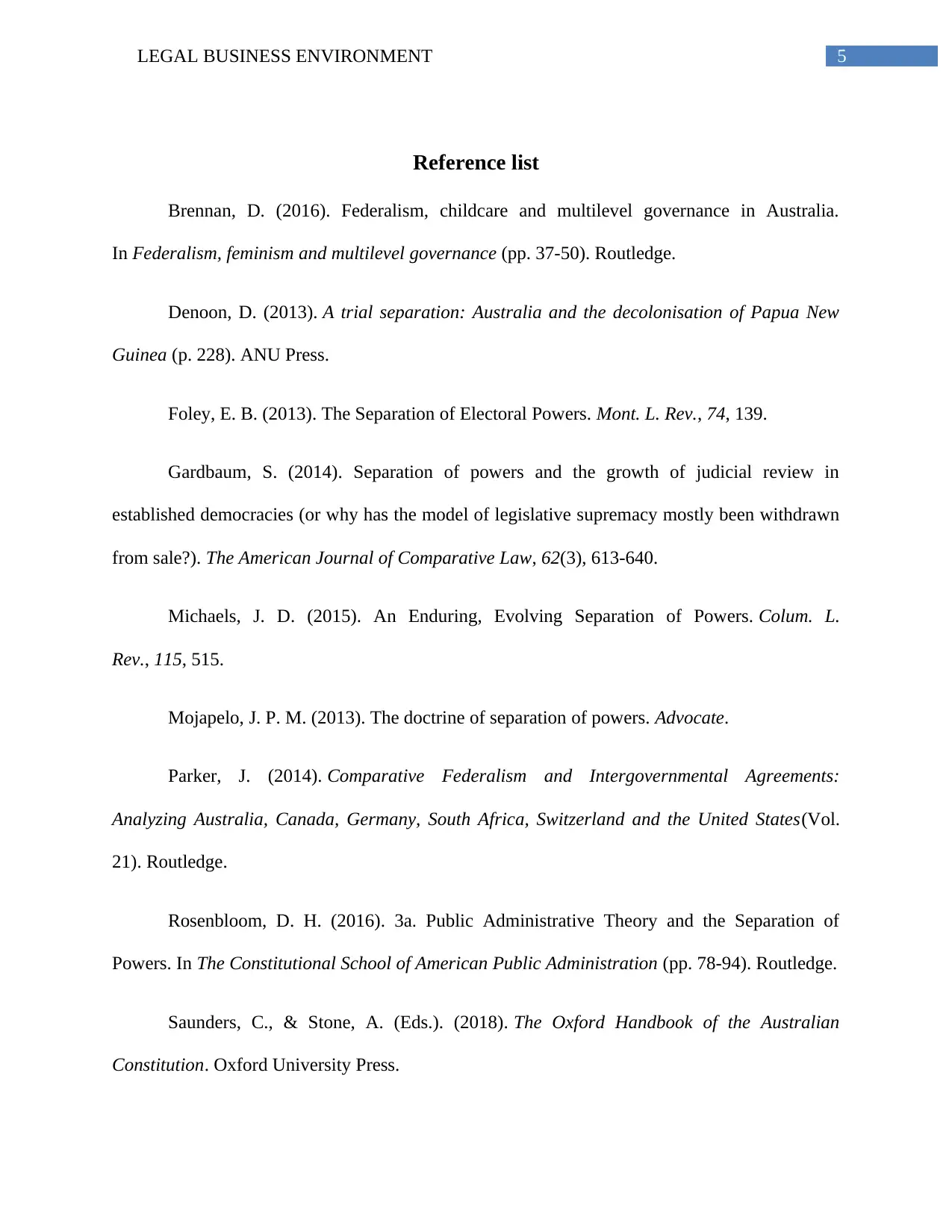
5LEGAL BUSINESS ENVIRONMENT
Reference list
Brennan, D. (2016). Federalism, childcare and multilevel governance in Australia.
In Federalism, feminism and multilevel governance (pp. 37-50). Routledge.
Denoon, D. (2013). A trial separation: Australia and the decolonisation of Papua New
Guinea (p. 228). ANU Press.
Foley, E. B. (2013). The Separation of Electoral Powers. Mont. L. Rev., 74, 139.
Gardbaum, S. (2014). Separation of powers and the growth of judicial review in
established democracies (or why has the model of legislative supremacy mostly been withdrawn
from sale?). The American Journal of Comparative Law, 62(3), 613-640.
Michaels, J. D. (2015). An Enduring, Evolving Separation of Powers. Colum. L.
Rev., 115, 515.
Mojapelo, J. P. M. (2013). The doctrine of separation of powers. Advocate.
Parker, J. (2014). Comparative Federalism and Intergovernmental Agreements:
Analyzing Australia, Canada, Germany, South Africa, Switzerland and the United States(Vol.
21). Routledge.
Rosenbloom, D. H. (2016). 3a. Public Administrative Theory and the Separation of
Powers. In The Constitutional School of American Public Administration (pp. 78-94). Routledge.
Saunders, C., & Stone, A. (Eds.). (2018). The Oxford Handbook of the Australian
Constitution. Oxford University Press.
Reference list
Brennan, D. (2016). Federalism, childcare and multilevel governance in Australia.
In Federalism, feminism and multilevel governance (pp. 37-50). Routledge.
Denoon, D. (2013). A trial separation: Australia and the decolonisation of Papua New
Guinea (p. 228). ANU Press.
Foley, E. B. (2013). The Separation of Electoral Powers. Mont. L. Rev., 74, 139.
Gardbaum, S. (2014). Separation of powers and the growth of judicial review in
established democracies (or why has the model of legislative supremacy mostly been withdrawn
from sale?). The American Journal of Comparative Law, 62(3), 613-640.
Michaels, J. D. (2015). An Enduring, Evolving Separation of Powers. Colum. L.
Rev., 115, 515.
Mojapelo, J. P. M. (2013). The doctrine of separation of powers. Advocate.
Parker, J. (2014). Comparative Federalism and Intergovernmental Agreements:
Analyzing Australia, Canada, Germany, South Africa, Switzerland and the United States(Vol.
21). Routledge.
Rosenbloom, D. H. (2016). 3a. Public Administrative Theory and the Separation of
Powers. In The Constitutional School of American Public Administration (pp. 78-94). Routledge.
Saunders, C., & Stone, A. (Eds.). (2018). The Oxford Handbook of the Australian
Constitution. Oxford University Press.
⊘ This is a preview!⊘
Do you want full access?
Subscribe today to unlock all pages.

Trusted by 1+ million students worldwide
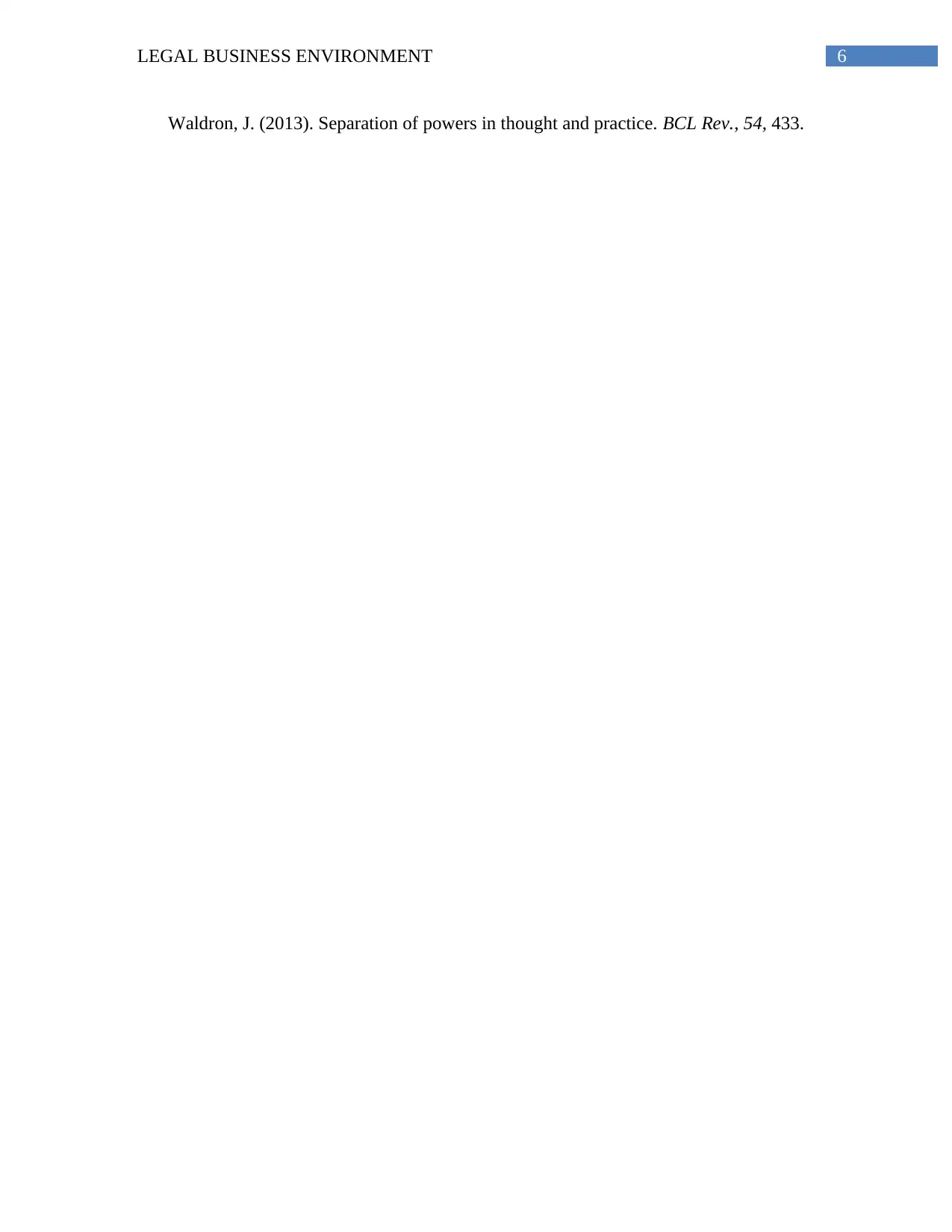
6LEGAL BUSINESS ENVIRONMENT
Waldron, J. (2013). Separation of powers in thought and practice. BCL Rev., 54, 433.
Waldron, J. (2013). Separation of powers in thought and practice. BCL Rev., 54, 433.
1 out of 7
Related Documents
Your All-in-One AI-Powered Toolkit for Academic Success.
+13062052269
info@desklib.com
Available 24*7 on WhatsApp / Email
![[object Object]](/_next/static/media/star-bottom.7253800d.svg)
Unlock your academic potential
Copyright © 2020–2025 A2Z Services. All Rights Reserved. Developed and managed by ZUCOL.




